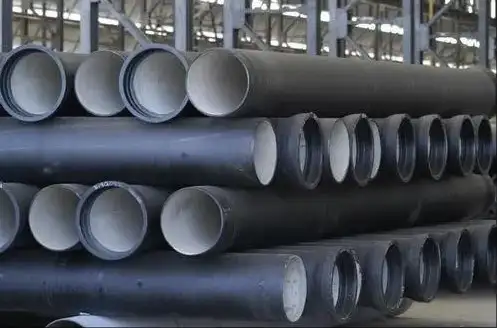تُستخدم أنابيب حديد الدكتايل على نطاق واسع في أنظمة توزيع المياه نظراً لقوتها ومتانتها ومقاومتها للتآكل. يختلف سعر أنبوب حديد الدكتايل مقاس 4 بوصة بناءً على عدة عوامل، بما في ذلك مواصفات المواد وأنواع الوصلات وظروف السوق الإقليمية. يقدم هذا الدليل نظرة متعمقة على الأسعار الحالية، والعوامل المؤثرة على التكاليف، وإجابات على الأسئلة الشائعة المتعلقة بأنابيب حديد الدكتايل مقاس 4 بوصة.

فهم أنابيب حديد الدكتايل
أنابيب حديد الدكتايل هي نوع من أنابيب الحديد الزهر المعروفة بقوتها وليونتها المعززة، والتي تتحقق من خلال إضافة كميات صغيرة من المغنيسيوم. تُستخدم هذه الأنابيب بشكل شائع في أنظمة المياه والصرف الصحي، وتقدم مزايا مثل:
-
قوة عالية: قادرة على تحمل الضغوط الداخلية العالية.
-
مقاومة التآكل: مناسبة لمختلف ظروف التربة.
-
طول العمر: عمر خدمة طويل مقارنةً بالمواد الأخرى.
يتأثر سعر أنابيب حديد الدكتايل بعوامل مثل القطر والفئة ونوع الوصلة والطلاء وظروف السوق الإقليمية.
العوامل المؤثرة في سعر أنابيب حديد الدكتايل مقاس 4 بوصة
تساهم عدة عناصر في تكلفة أنبوب من حديد الدكتايل بقطر 4 بوصة:
1. فئة الأنابيب
تشير فئة أنبوب حديد الدكتايل إلى معدل ضغطه. تشمل الفئات الشائعة ما يلي:
-
الفئة 52: تصنيف الضغط القياسي.
-
الفئة 350: معدل ضغط أعلى.
-
الفئة 250: تصنيف الضغط المنخفض.
تكلف الأنابيب من الدرجة الأعلى بشكل عام أكثر بسبب زيادة قوة المواد وقدرات التعامل مع الضغط.
2. النوع المشترك
تؤثر طريقة توصيل أقسام الأنابيب على السعر:
-
تيتون جوينت وصلة دفع مع حشية.
-
الوصلة الميكانيكية: وصلة مثبتة بمسامير.
-
مفصل مقيد: يمنع الحركة تحت الضغط.
عادةً ما تكون الوصلات المقيدة أكثر تكلفة بسبب وظائفها الإضافية.
3. الطلاء والتبطين
تعمل الطلاءات والبطانات الواقية على تعزيز مقاومة التآكل:
-
تبطين الملاط الأسمنتي: معيار لمياه الشرب.
-
غلاف من البولي إيثيلين: حماية إضافية للتربة العدوانية.
تزيد الطلاءات المتخصصة من التكلفة الإجمالية للأنبوب.
4. الطول والوزن
عادةً ما تكون الأطوال القياسية 18 أو 20 قدماً. قد تترتب على الأنابيب الأطول أو الأثقل تكلفة شحن أعلى.
5. ظروف السوق
يمكن أن يتسبب الطلب الإقليمي وعوامل سلسلة التوريد وتكاليف المواد الخام في تقلبات الأسعار.
مقارنة الأسعار حسب المنطقة والمورد
| المورد | سعر القدم الواحدة | النوع المشترك | الطلاء/التبطين | المنطقة |
|---|---|---|---|---|
| A. لويس للتوريدات | $53.25 | تيتون جوينت | قياسي | شمال شرق أوهايو |
| شركة مياه لويزفيل | $41.82 | غير محدد | غير محدد | لويزفيل، كنتاكي |
| مياه فيرفاكس | $22.71 | مطلي بالزنك | ملاط أسمنتي | فيرفاكس، فيرجينيا |
| الماكينةMFG | $22.71 | غير محدد | غير محدد | الصين |
| علي بابا (الشراء بالجملة) | $365.00 | غير محدد | غير محدد | الصين |
ملاحظة: الأسعار استرشادية وقد تختلف بناءً على المتطلبات المحددة وظروف السوق.
تقدير التكلفة التقديرية للتركيب
تشمل التكلفة الإجمالية لتركيب أنبوب من حديد الدكتايل 4 بوصة ما يلي:
-
التكاليف المادية: بناءً على سعر القدم الواحدة.
-
تكاليف العمالة: تختلف أسعار عمالة التركيب حسب المنطقة.
-
تكاليف المعدات: معدات الحفر وحفر الخنادق.
-
رسوم التصاريح والفحص: متطلبات الحكومة المحلية.
في المتوسط، تتراوح تكلفة التركيب من $8.40 إلى $24.00 للقدم الطولي الواحد، اعتمادًا على العوامل المذكورة أعلاه.
مزايا استخدام أنابيب حديد الدكتايل
توفر أنابيب حديد الدكتايل العديد من المزايا:
-
المتانة: عمر خدمة طويل مع الحد الأدنى من الصيانة.
-
القوة: يمكن أن تتحمل الضغوط الداخلية العالية.
-
مقاومة التآكل: مناسبة لمختلف ظروف التربة.
-
تعدد الاستخدامات: قابلة للتطبيق في مجموعة كبيرة من التركيبات.
الأسئلة الشائعة (FAQs)
1. ما هو الطول القياسي لأنبوب حديد الدكتايل مقاس 4 بوصة؟
عادةً ما تكون الأطوال القياسية لأنابيب حديد الدكتايل 18 أو 20 قدماً. ومع ذلك، يمكن طلب أطوال مخصصة بناءً على متطلبات المشروع.
2. كيف تؤثر فئة أنبوب حديد الدكتايل على سعره؟
تشير الفئة إلى معدل ضغط الأنبوب. الأنابيب من الفئة الأعلى، مثل الفئة 350، مصممة للتعامل مع ضغوط أعلى، وهي أغلى عموماً بسبب زيادة قوة المواد وعمليات التصنيع.
3. ما هي فوائد استخدام الوصلات المقيدة في أنابيب حديد الدكتايل؟
تمنع الوصلات المقيدة الحركة تحت الضغط، وهو أمر بالغ الأهمية في بعض التطبيقات حيث يمكن أن تتسبب ظروف التربة أو المطرقة المائية في الإزاحة. وعلى الرغم من أنها أكثر تكلفة، إلا أنها توفر المزيد من الأمان والاستقرار لنظام خطوط الأنابيب.
4. لماذا تختلف الأسعار بين الموردين والمناطق؟
يمكن أن تختلف الأسعار بسبب عوامل مثل الطلب المحلي وتكاليف النقل والظروف الاقتصادية الإقليمية واستراتيجيات تسعير الموردين. من الضروري الحصول على عروض أسعار من عدة موردين لضمان الحصول على أسعار تنافسية.
5. هل هناك أي بدائل فعالة من حيث التكلفة لأنابيب حديد الدكتايل؟
على الرغم من أن أنابيب حديد الدكتايل توفر متانة وقوة ممتازة، إلا أن البدائل مثل أنابيب PVC أو أنابيب HDPE قد تكون أكثر فعالية من حيث التكلفة لبعض التطبيقات. ومع ذلك، قد لا توفر هذه المواد نفس المستوى من الأداء في البيئات عالية الضغط أو البيئات المسببة للتآكل.
الخاتمة
يختلف سعر أنبوب حديد الدكتايل مقاس 4 بوصة بناءً على عدة عوامل، بما في ذلك فئة الأنبوب، ونوع الوصلة، والطلاء، وظروف السوق الإقليمية. يمكن أن يساعد فهم هذه العناصر في اتخاذ قرارات مستنيرة عند شراء أنابيب حديد الدكتايل لأنظمة توزيع المياه.
للحصول على تسعير دقيق ولضمان أفضل ملاءمة لمشروعك، يُنصح بالتشاور مع الموردين والحصول على عروض أسعار مفصلة تأخذ في الاعتبار جميع العوامل ذات الصلة.
